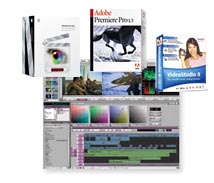Video Editing Software
 Deciding which video editing software to use is not easy. There is a huge range available, from very basic applications such as Windows Movie Maker to professional packages such as Final Cut Pro, ULead MediaStudio and Adobe Premiere.
Deciding which video editing software to use is not easy. There is a huge range available, from very basic applications such as Windows Movie Maker to professional packages such as Final Cut Pro, ULead MediaStudio and Adobe Premiere.
For most people, the main constraint is money. Good editing software is expensive and often requires a high-priced computer to run effectively. Obviously the more money you can spend the better, but you can achieve reasonable results with software costing less than $US500.
Very cheap or free software (e.g. Windows Movie Maker) tends to be very limited and somewhat impractical. If you are at all serious you will need to spend some money.
Note that many capture devices and cameras come with their own editing software, or perhaps a limited version of a professional package. This can be a cost-effective way to get started.
How Editing Software Works
Most general-purpose editing software does three things:
- Capture
- Edit
- Output
This means the software controls the capturing (recording) of the footage, provides a way to edit the footage, and allows the finished product to be output to a recording device such as a VCR or DVD.
If you like, you can use separate software for capture or output, but initially you will probably find it more convenient to use the same program for all tasks.
Projects
Although the terminology may vary, non-linear video editing is founded on the concept of a project. An editing project is a collection of elements which are used to create the finished product. Elements can include video clips, audio clips, titles, graphics, etc.
The project also includes information about how these elements are arranged in the edit. In effect, a project consists of all the individual elements and instructions on how they are put together. When you create a video project, you import or capture the elements you need, then arrange them in the order you want (adding effects and other goodies if you like).
What to Look For in Editing Software
- Make sure it is compatible with your hardware and operating system.
- Check the capture, import and export options. Make sure it can handle the formats and resolution you want to use.
- Does the software allow for layering and effects? What other advanced features does it have?
- Is there any other software bundled with the package (e.g. audio editing)?
- Is it compatible with other common software (e.g. Adobe Photoshop)?
Next Page: Capturing Video